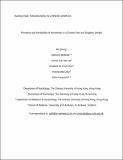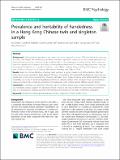Files in this item
Prevalence and heritability of handedness in a Hong Kong Chinese twin and singleton sample
Item metadata
| dc.contributor.author | Zheng, Mo | |
| dc.contributor.author | McBride, Catherine | |
| dc.contributor.author | Ho, Connie Suk-Han | |
| dc.contributor.author | Chan, Jonathan Ka-Chun | |
| dc.contributor.author | Choy, Kwong Wai | |
| dc.contributor.author | Paracchini, Silvia | |
| dc.date.accessioned | 2020-04-23T14:30:23Z | |
| dc.date.available | 2020-04-23T14:30:23Z | |
| dc.date.issued | 2020-04-22 | |
| dc.identifier | 262190904 | |
| dc.identifier | 9d8032b4-1fcb-45b8-a7a2-b53999c8a5b6 | |
| dc.identifier | 85083948737 | |
| dc.identifier | 000700872900001 | |
| dc.identifier.citation | Zheng , M , McBride , C , Ho , C S-H , Chan , J K-C , Choy , K W & Paracchini , S 2020 , ' Prevalence and heritability of handedness in a Hong Kong Chinese twin and singleton sample ' , BMC Psychology , vol. 8 , 37 . https://doi.org/10.1186/s40359-020-00401-9 | en |
| dc.identifier.issn | 2050-7283 | |
| dc.identifier.other | ORCID: /0000-0001-9934-8602/work/72842974 | |
| dc.identifier.uri | https://hdl.handle.net/10023/19848 | |
| dc.description | Funding: Research Grants Council of the Hong Kong Special Administration Region (CUHK8/CRF/13G & C4054-17WF), by an internal grant entitled “Reading Development in Chinese and in English: Genetics and Neuroscience Correlates”(4930703) from The Chinese University of Hong Kong (CM is the PI on both grants), by a Hong Kong: Scotland Collaborative Research Partnership award from the Hong Kong Grants Council (CMis the PI for the Hong Kong side) and the Scottish Funding Council (SP is the PI for the Scotland side). It was additionally funded by an International Exchange Kan Tongo Po Visiting Fellowship to SP. SP is a Royal Society University Research Fellow. | en |
| dc.description.abstract | Background Left-handedness prevalence has been consistently reported at around 10% with heritability estimates at around 25%. Higher left-handedness prevalence has been reported in males and in twins. Lower prevalence has been reported in Asia, but it remains unclear whether this is due to biological or cultural factors. Most studies are based on samples with European ethnicities and using the preferred hand for writing as key assessment. Here, we investigated handedness in a sample of Chinese school children in Hong Kong, including 426 singletons and 205 pairs of twins, using both the Edinburgh Handedness Inventory and Pegboard Task. Results Based on a binary definition of writing hand, we found a higher prevalence of left-handedness (8%) than what was previously reported in Asian datasets. We found no evidence of increased left-handedness in twins, but our results were in line with previous findings showing that males have a higher tendency to be left-handed than females. Heritability was similar for both hand preference (21%) and laterality indexes (22%). However, these two handedness measures present only a moderate correlation (.42) and appear to be underpinned by different genetic factors. Conclusion In summary, we report new reference data for an ethnic group usually underrepresented in the literature. Our heritability analysis supports the idea that different measures will capture different components of handedness and, as a consequence, datasets assessed with heterogeneous criteria are not easily combined or compared. | |
| dc.format.extent | 31 | |
| dc.format.extent | 148569 | |
| dc.format.extent | 530356 | |
| dc.language.iso | eng | |
| dc.relation.ispartof | BMC Psychology | en |
| dc.subject | Handedness | en |
| dc.subject | Edinburgh handedness inventory | en |
| dc.subject | Pegboard | en |
| dc.subject | Chinese children | en |
| dc.subject | Twins | en |
| dc.subject | QH426 Genetics | en |
| dc.subject | RC0321 Neuroscience. Biological psychiatry. Neuropsychiatry | en |
| dc.subject | DAS | en |
| dc.subject.lcc | QH426 | en |
| dc.subject.lcc | RC0321 | en |
| dc.title | Prevalence and heritability of handedness in a Hong Kong Chinese twin and singleton sample | en |
| dc.type | Journal article | en |
| dc.contributor.sponsor | Scottish Government | en |
| dc.contributor.sponsor | The Royal Society | en |
| dc.contributor.institution | University of St Andrews. School of Medicine | en |
| dc.identifier.doi | 10.1186/s40359-020-00401-9 | |
| dc.description.status | Peer reviewed | en |
| dc.identifier.url | https://doi.org/10.31234/osf.io/anq79 | en |
| dc.identifier.url | https://osf.io/pcg8m/ | en |
| dc.identifier.grantnumber | N/A | en |
| dc.identifier.grantnumber | KT160031 | en |
This item appears in the following Collection(s)
Items in the St Andrews Research Repository are protected by copyright, with all rights reserved, unless otherwise indicated.


